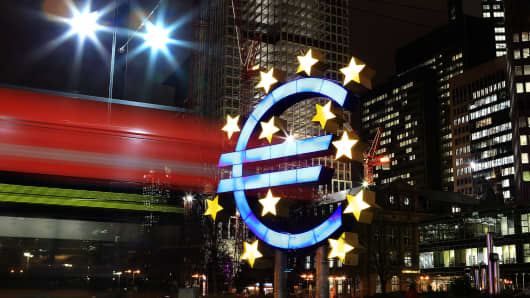Euro zone finance ministers will decide on Thursday when and how their bailout fund can invest in a bank to save it from failure, laying a cornerstone of the banking union seen as vital to restore economic growth.
Ministers from the 17 countries using the euro will also set guidelines for how much a government would have to contribute to such a bank rescue, which banks would be eligible, and who would lose money in the process.
"We will reach a decision on all aspects of direct recapitalization," a senior European Union official involved in preparations for the meeting said.
Euro zone leaders want the European Stability Mechanism (ESM) bailout fund to be able to become a shareholder in a systemically important bank so that the expense of saving the institution does not fall just on the shoulders of a government that may already be struggling with huge debts.
The possibility of such direct recapitalization should help boost confidence among euro zone banks, encouraging them to lend to the real economy and so boost growth.
The discussions are closely linked to talks on Friday, when the euro zone ministers will be joined by colleagues from other European Union countries, on a broader law to rescue or close down a failing bank.
(Read More: Cyprus Calls for Bailout Overhaul to Save Economy)
The bank recovery and resolution directive covers some similar ground to the ESM direct recapitalization guidelines, for example who loses money, and when, if a bank is rescued or wound down.
That is why guidelines for ESM, while expected to be agreed in principle on Thursday, will only be finalized in a legal form once the European Parliament votes through the directive.
The ministers will have to decide if they want the ESM rules to match EU state aid law that comes into force in August and foresees losses only for shareholders and junior bondholders, or the still-not-finalized directive, under which also senior bondholders and even large bank depositors could take a hit.
From Autumn 2014
The ESM will be able to become a shareholder in a failing, but systemically important euro zone bank only in the second half of the 2014, the senior EU official said.
This is in line with a decision by EU leaders that the European Central Bank must first establish itself as the supervisor of euro zone banks, which is now expected to take place in September 2014.
On Thursday, the ministers will also decide exactly how much money from the ESM's 500 billion euro war chest they want to earmark for potential investment in banks. The range pencilled in now is 50 to 70 billion euros.
(Read More: George Osborne Renews Backing for Bank Competition)
To deal with banks that need recapitalizing because of bad assets accumulated earlier, or legacy assets, the guidelines will say that before the ESM can invest, its national government must top up the bank's capital so that it meets the legal minimum of common equity Tier 1 ratio of 4.5 percent.
If a bank already meets that minimum requirement, the government would still have to provide between 10 and 20 percent of the needed capital increase so as to make sure that it is in the sovereign's interest to keep the bank healthy.
On Thursday, the ministers are to decide more specifically what number from the 10-20 percent range to pick.
They will also set a general rule on whether the ESM can take a decision in the second half of 2014 to become a shareholder in a bank that got into trouble before that date - what EU policy-makers call retroactivity.
(Read More: What Taxpayer Bailouts? Euro Crisis Saves Germany Money)
The options include all banks being eligible or none, or that they be evaluated on a case-by-case basis.
Ireland may be interested in the ESM buying stakes in its banks, as might Greece, Cyprus and Portugal, but Spain has said it would not seek such an option so as not to send a signal to the markets that the sovereign cannot cope on its own.



